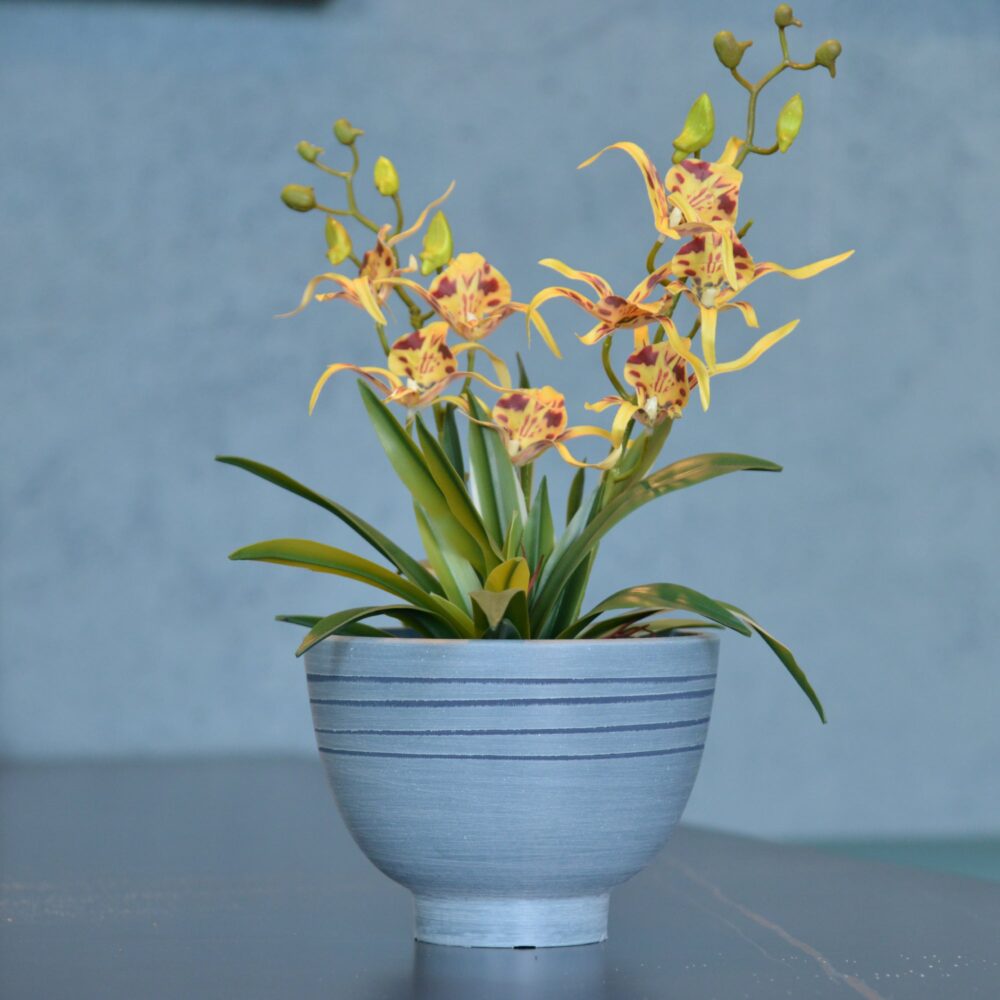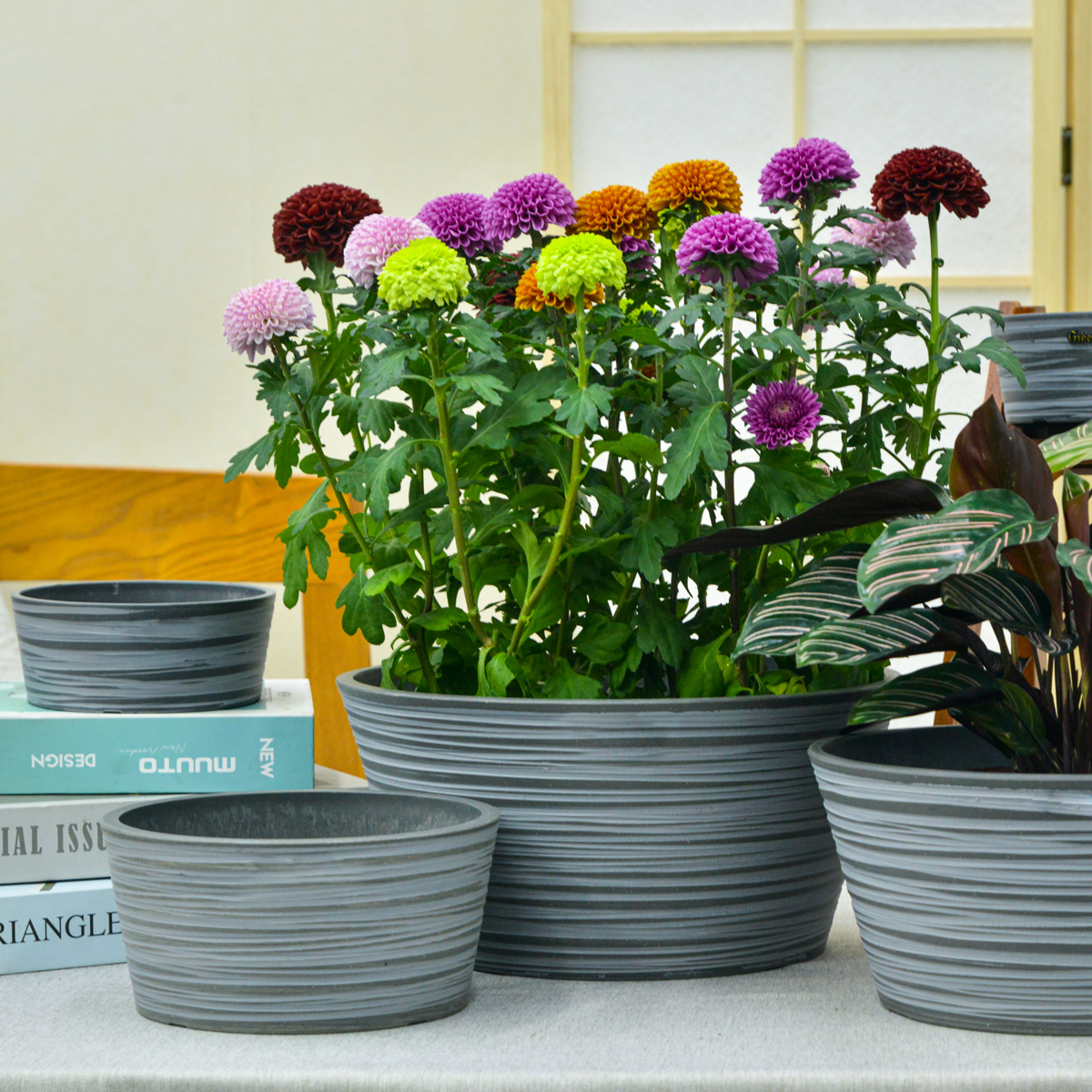Lobelia in Pots: The Ultimate Guide to Growing Stunning Lobelia in Outdoor Containers
Want to add a touch of vibrant blue, purple, pink, or white to your patio, balcony, or garden? Lobelia are a classic and beloved choice for outdoor container gardening, prized for their profusion of delicate, jewel-toned flowers and their cascading or upright growth habits. From classic trailing lobelia perfect for hanging baskets to upright varieties for mixed containers, lobelia are versatile and beautiful additions to any outdoor space. This comprehensive guide will provide you with everything you need to know to grow lobelia successfully in outdoor pots, from selecting the best varieties and containers to mastering essential care techniques for a season filled with lobelia beauty.

Lobelia
What are Lobelia (Lobelia)?
Lobelia (Lobelia) is a large genus of flowering plants in the bellflower family, Campanulaceae, with over 400 species distributed worldwide, with a high concentration in tropical and warmer temperate regions. Many lobelia species are popular annual bedding plants (though some are perennial in warmer zones), cherished for their intense, vibrant flower colors and long blooming season. Lobelia flowers are typically small, intricately shaped, and often two-lipped or fan-shaped, and come in a range of colors, most famously various shades of blue and purple, but also pink, red, white, and bi-colors. They are broadly categorized into types based on growth habit, including Trailing Lobelia and Upright Lobelia. Lobelia are cherished for their intense flower color, delicate appearance, long blooming season, and versatility in containers and garden beds, making them a favorite for adding fine texture and vibrant hues to any outdoor setting.
Are Lobelia (Lobelia) Good for Outdoor Pots?
Yes, Lobelia (Lobelia) are exceptionally well-suited for outdoor pots and container gardening. Their trailing, cascading, and compact upright growth habits make them ideal for filling pots, window boxes, hanging baskets, and mixed container arrangements with abundant color. Lobelia thrive in consistently moist soil and bloom profusely throughout the cool to warm seasons, providing a long-lasting and delicate floral display in containers. Their versatility in growth habit and intense flower colors make them a fantastic and rewarding choice for container gardens of all styles, especially for adding fine texture and vibrant hues to patios, balconies, and decks.
Ideal Growing Conditions for Lobelia (Lobelia) in Pots:
- Types of Lobelia for Pots: Both trailing and upright lobelia types are excellent for pots, but consider your desired look and container type when choosing:
- Trailing Lobelia (Lobelia erinus varieties): (e.g., ‘Cascade Series’, ‘Techno Series’, ‘Sapphire’, ‘Regatta Series’) – Vining and cascading, typically trailing 6-18 inches, perfect for hanging baskets, window boxes, and spilling over pot edges. Known for their classic trailing habit, profusion of small flowers, and availability in intense blues, purples, pinks, and whites. Excellent for creating waterfalls of color and softening container edges.
- Upright Lobelia (Lobelia erinus and Lobelia x speciosa varieties): (e.g., Lobelia erinus ‘Compact Crystal Palace’, Lobelia x speciosa ‘Fan Series’, ‘Starship Series’) – Bushy and upright, typically reaching 6-24 inches tall, suitable for standard pots, mixed containers, and adding vertical interest. Upright Lobelia erinus varieties are more compact, while Lobelia x speciosa hybrids tend to be taller and more robust. Good for adding structure and height to container arrangements.
- Perennial Lobelia (Hardy Lobelia) (Lobelia cardinalis, Lobelia siphilitica, Lobelia x gerardii): (e.g., Lobelia cardinalis ‘Queen Victoria’, Lobelia siphilitica ‘Blue Lobelia’, Lobelia x gerardii ‘Vedra’) – Hardy in certain zones (check hardiness for specific species/varieties), these lobelia types are often taller and more upright, and can be grown in larger pots as focal points or in mixed perennial containers. Offer a more robust, longer-lived option for container gardening in suitable climates. Lobelia cardinalis (Cardinal Flower) features striking red blooms, while Lobelia siphilitica (Great Blue Lobelia) offers beautiful blue flowers. Lobelia x gerardii hybrids come in various colors and are often more adaptable.
- Light: Lobelia thrive in full sun to partial shade. They bloom best and produce the most vibrant colors in full sun(at least 6-8 hours of direct sunlight per day), especially in cooler climates. In hot summer climates, partial shade, especially during the hottest afternoon hours, is often beneficial to prevent heat stress and prolong bloom time. In very shady locations, lobelia may produce fewer blooms and become leggy. Choose a location for your lobelia containers that provides full sun or partial shade, depending on your climate.
- Soil: Lobelia need consistently moist, well-draining soil that is rich in organic matter. Use a high-quality potting mix specifically formulated for containers or flowers. Amend potting mix with peat moss or coco coir to improve moisture retention and drainage, and compost to enhance fertility. Avoid heavy, compacted soil or garden soil in pots, as they can become waterlogged. A slightly acidic to neutral pH (around 6.0-7.0) is ideal for lobelia. Consistent moisture retention is key for lobelia in pots.
- Watering: Lobelia need consistently moist soil and are not drought-tolerant. Water thoroughly and frequently to keep the soil evenly moist, especially during hot, dry weather. Water when the top inch of soil feels slightly dry. Water deeply until water drains out of the drainage holes. Do not allow the soil to dry out completely, even for short periods, as lobelia will wilt quickly and may suffer damage from drying out. However, they also do not like to be waterlogged. Aim for consistently moist, but not soggy soil. Watering frequency will depend on weather conditions, light levels, pot size, and plant size. During hot, sunny, or windy weather, you may need to water daily, or even twice a day, especially for hanging baskets and smaller pots which dry out rapidly. Check soil moisture regularly and adjust watering accordingly. Water at the base of the plant to keep foliage and flowers dry and help prevent fungal diseases.
- Temperature: Lobelia are cool-season annuals that thrive in moderate temperatures. They perform best in temperatures between 55°F to 75°F (13°C to 24°C). They are tolerant of light frost but are damaged by hard freezes. Plant lobelia outdoors after the last frost in your area, or start seeds indoors 8-10 weeks before the last frost for earlier blooms. They bloom best in cooler periods of spring and fall, and may slow down or stop blooming in the heat of summer, especially in very hot climates. Providing afternoon shade and consistent moisture can help them tolerate summer heat.
- Fertilizer: Lobelia are moderate feeders and benefit from regular fertilization, especially when grown in pots where nutrients can leach out more quickly. Fertilize every 2-4 weeks during the blooming season to encourage continuous flowering. Use a balanced liquid fertilizer (e.g., 10-10-10 or 20-20-20) diluted to half strength, or a fertilizer specifically formulated for flowering annuals. Avoid over-fertilizing, which can lead to leggy growth and fewer flowers.
Choosing the Right Pots for Lobelia (Lobelia):
- Suitable Pot Types: Lobelia are versatile and can be grown in various pot types, including terracotta, ceramic, plastic, resin, hanging baskets, and window boxes. Consider these factors when selecting pot types for lobelia:
- Plastic Pots: Lightweight, inexpensive, retain moisture well, available in various colors and styles. Excellent choice for lobelia, especially for moisture-loving trailing types and hanging baskets. Choose good quality plastic pots that are durable and UV-resistant.
- Resin Pots: Lightweight, durable, available in various styles mimicking terracotta or ceramic, and retain moisture well. A good alternative to heavy ceramic pots, and often offer better moisture retention than terracotta.
- Ceramic Pots: Available in many decorative styles, can add a decorative element to your container garden, and retain moisture reasonably well. Ensure good drainage. Good for upright lobelia and mixed arrangements.
- Terracotta Pots: Porous, allow good aeration and drainage, and aesthetically classic, but dry out very quickly, requiring very frequent watering, especially in hot weather. May be less ideal for lobelia due to their need for consistent moisture, unless you are diligent about watering and choose larger pots. Best suited for cooler climates or for gardeners who prefer to water frequently.
- Hanging Baskets: Ideal for trailing lobelia, create cascading displays of color. Require very frequent watering and fertilization due to their exposed nature and quick drying. Line baskets with coco coir or sphagnum moss to help retain moisture.
- Window Boxes & Long Planters: Excellent for mass plantings of trailing or upright lobelia, or mixed arrangements, on windowsills, railings, or as porch planters. Trailing types will spill beautifully over the edges. Choose boxes with good drainage and sufficient depth.
- Drainage: Good drainage is important, but moisture retention is even more critical for lobelia. Ensure your chosen pot has drainage holes at the bottom to prevent waterlogging, but choose pot materials and potting mixes that help retain moisture. Avoid pots without drainage holes. Elevating pots slightly can improve drainage and air circulation around the base. Adding a layer of gravel or pot shards at the base of the pot is generally not necessary if using a well-draining, moisture-retentive potting mix.
- Pot Size: Choose pot sizes appropriate for the type and mature size of the lobelia you are planting.
- Trailing Lobelia: For trailing lobelia, hanging baskets and pots should be at least 8-10 inches in diameter, and can be larger for more mature displays and to accommodate multiple plants. Deeper pots are better to allow for more root development.
- Upright Lobelia: For upright lobelia, pots that are 6-8 inches in diameter are suitable for individual plants. For fuller displays or multiple plants, use pots that are 8-12 inches or larger, or window boxes.
- Perennial Lobelia: For perennial lobelia, use larger pots that are 10-12 inches in diameter or larger to accommodate their mature size and root systems, especially for taller varieties.
- Depth: Ensure pots are at least 6-8 inches deep for most lobelia types. Deeper pots are better for trailing and perennial varieties.
- Color and Style: Choose pot colors and styles that complement your lobelia blooms and your outdoor décor. Cool-toned pots in blues, purples, or grays can enhance the jewel tones of lobelia flowers, while neutral pots can provide a more understated elegance. Consider using lighter colored pots in sunny locations to help keep soil temperatures cooler.
Essential Care Tips for Thriving Lobelia (Lobelia) in Outdoor Pots:
- Watering: “Keep Soil Consistently Moist, Never Let Dry Out”. Water thoroughly and frequently to keep the soil evenly moist. Water when the top inch of soil feels slightly dry. Never allow soil to dry out completely. Water more frequently in hot, sunny, or windy weather, and for hanging baskets and smaller pots. Avoid overwatering and soggy soil, but err on the side of keeping soil consistently moist.
- Sunlight: Provide Full Sun to Partial Shade. Place lobelia pots in a location that receives full sun for best blooming in cooler climates, or partial shade in hotter climates, especially during the hottest afternoon hours.
- Fertilizing: Feed Every 2-4 Weeks During Blooming Season. Fertilize every 2-4 weeks with a balanced liquid fertilizer or flowering plant fertilizer to encourage continuous blooming. Avoid over-fertilizing.
- Deadheading (Encourage More Blooms & Tidiness): Deadhead spent or faded flowers regularly to encourage more blooms and keep plants looking tidy. Pinch or snip off dead flower heads right below the flower. Regular deadheading promotes continuous flowering in lobelia.
- Pinching Back/Trimming (Revive Leggy Plants & Promote Bushiness): Lobelia can sometimes become leggy or stop blooming in mid-summer heat. Pinch back or lightly trim back leggy stems or overgrown plants to encourage bushier growth and potentially re-blooming when cooler temperatures return. A light trim can rejuvenate plants.
- Pest and Disease Control: Lobelia are generally relatively pest and disease-resistant, but monitor for common pests like aphids, spider mites, and slugs/snails. Fungal diseases like root rot and botrytis blight can occur, especially in overly wet or humid conditions. Ensure good air circulation, avoid overcrowding, water at the base of the plant, and provide good drainage. Treat any pest or disease issues promptly with insecticidal soap, horticultural oil, neem oil, or appropriate fungicides if necessary.
Popular Lobelia Cultivars for Pots (by Type):
- Trailing Lobelia (Lobelia erinus): ‘Cascade Series’, ‘Techno Series’, ‘Sapphire’, ‘Regatta Series’, ‘Fountain Series’, ‘Riviera Series’
- Upright Lobelia (Lobelia erinus and Lobelia x speciosa): Lobelia erinus ‘Crystal Palace’, Lobelia erinus‘Compact Blue’, Lobelia x speciosa ‘Fan Series’, Lobelia x speciosa ‘Starship Series’, Lobelia x speciosa ‘Hadspen Purple’
- Perennial Lobelia (Hardy Lobelia): Lobelia cardinalis ‘Queen Victoria’, Lobelia siphilitica ‘Blue Lobelia’, Lobelia x gerardii ‘Vedra’, Lobelia x gerardii ‘Fan Burgundy’
In Summary:
Growing Lobelia (Lobelia) in outdoor pots is a wonderfully rewarding way to add intense, jewel-toned color and delicate beauty to your patios, balconies, and gardens. Their versatile growth habits and long blooming season make them a perfect choice for container gardeners seeking fine texture and vibrant hues. By providing full sun to partial shade, consistently moist and well-draining potting mix in pots with drainage, fertilizing regularly, and deadheading spent blooms, you can easily cultivate stunning lobelia displays in pots and enjoy their charming flowers all season long.

Lobelia
For more detailed botanical information and to explore the diverse world of Lobelia species and cultivars, you can visit the Wikipedia page on Lobelia.
Important Note: Lobelia (Lobelia) species can vary in toxicity. Some species, particularly Lobelia cardinalis and Lobelia siphilitica, are considered mildly toxic if ingested, potentially causing nausea, vomiting, or diarrhea. It’s advisable to keep plants out of reach of curious children and pets, or choose Lobelia erinus varieties which are generally considered less toxic. The primary care challenges with lobelia in pots are providing consistent moisture without overwatering, and preventing heat stress in hot summer climates. With attention to these needs and regular care, you can enjoy a season filled with the delicate and vibrant beauty of lobelia in your outdoor containers.
KC2-GS
By greenship|2024-08-16T06:30:21+00:00August 16, 2024|Categories: Hand-carving Series|
13 inch Planter for Indoor Plants, Set of 2 Modern Decorative Plant Pots with Drainage Hole, Cute Bowl Shape Flower Pots
By greenship-seo|2025-04-10T07:41:46+00:00January 10, 2025|Categories: Hand-carving Series|Tags: Decorative Flower Pots, Self-Watering Pots|
Planter for Indoor Outdoor Plants, Set of 2 Modern Decorative Plant Pots with Drainage Hole, Decorative Flower Pots
By greenship-seo|2025-01-14T12:26:44+00:00January 14, 2025|Categories: Hand-carving Series|Tags: Decorative Flower Pots|
KC2-11V
By greenship|2024-08-16T05:39:50+00:00August 16, 2024|Categories: Hand-carving Series|
8 inch/10 inch Planter Indoor Plants, 2 Pack Modern Decorative Plant Pots with Drainage Hole, Cute Bowl Shape Flower Pots
By greenship-seo|2025-04-10T08:03:42+00:00January 9, 2025|Categories: Hand-carving Series|Tags: Decorative Flower Pots, Self-Watering Pots|
11THD
By greenship|2024-08-13T02:52:20+00:00August 13, 2024|Categories: Hand-carving Series|






